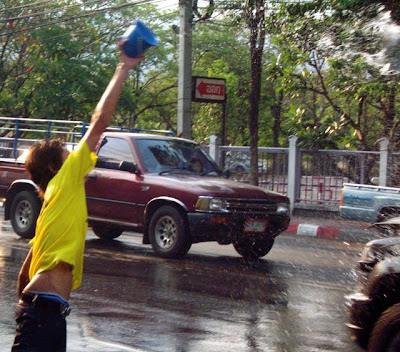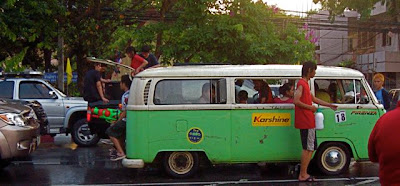But an influx of Thai artists and Western expatriates has turned this quiet city into a vibrant destination in its own right. Design studios have sprung up in town, fusing traditional Thai with modern twists. Age-old curries are now paired with Australian red wines and croissants. The area around Nimanhaemin Road now looks like South Beach, packed with BMWs and Art Deco homes, alongside contemporary art galleries run by young Thais with purple hair and nose rings. But traditional Chiang Mai is still there. Walk away from Nimanhaemin into the old city and you’ll see shaved monks meditating and backpackers chowing down on banana pancakes.
I have to say I was appalled by how Chiang Mai was treated. Like a Disney ride, a form of entertainment that is packaged to appeal to the New Yorker looking for something to do over the weekend.
I shouldn't be surprised. My own travel style is totally different from most people's and stems from my year as a student in Göttingen, Germany. We had to have two years of college German before going and then a six week (or was it eight?) intensive German language class before classes started in Germany. All classes were in German. I learned that being somewhere a while, learning the language, reveals a country and people one doesn't see right away. There's times for one's stereotypes to dissolve and for one to see what's happening more clearly and to reflect on things one always took for granted. If you really stay a while, you start to see your own culture through the eyes of the new one.
That year set the pattern for my preferred overseas travel style - find a reason and way to be there that puts you into the culture itself for an extended period. This means you are doing something that is, ideally, useful (besides spending money) to the local people and gets you out of the tourist/ex-pat community and into the real culture of the country. It also means a level of discomfort as you try to figure out how to do things that you do without thinking at home. And when you get past that discomfort a real feeling of satisfaction of now seeing the strange as normal. Of growing.
Using the local language is a big discomfort. Suddenly you're less articulate than a three year old. But we did learn enough Cantonese the year we were in Hong Kong to buy groceries and ask basic directions and to begin to appreciate the richness of that language. And for people to smile in appreciation that we made the effort to speak their language and not force them to speak ours in their country. It's not impossible as many told us. If we could get key phrases of that multi-toned toned Chinese dialect, every other language is well within reach. And learning some of the language is the key. (I think of all those English-only folks in the US who would freak if other countries weren't full of English signs and speakers. But maybe they don't travel abroad.)
I was overwhelmed by mastering German well enough to function in it. I was discovering that other languages were not merely translations of English. Instead, they had their own vocabulary and way of putting words together that led to concepts and ways of seeing the world that were different from how English speakers see things. So I wanted to learn yet another language - one completely different from English - and live in a totally foreign culture. That got me to Thailand through the Peace Corps when I graduated from the University.
So what's wrong with the article?
But an influx of Thai artists and Western expatriates has turned this quiet city into a vibrant destination in its own right.Right away, the point of view is not that of someone who knows and loves Thailand (though Josh's bio says he lived in Bangkok and he does know about khao soi, but what taxi drivers could/would pay 150 baht for noodles?), but it's the voice of an outsider. Chiang Mai is a destination. A place to come to and then leave in 36 hours. It's a way to keep one's life exciting. What about the people in Chiang Mai whose streets have gotten so incredibly jammed with cars? Whose small houses and gardens are being ripped apart to build high rises for foreigners to live in? The farmers whose land is being bought from them by speculators and then sold to developers who build Western style gated communities?
Design studios have sprung up in town, fusing traditional Thai with modern twists. Age-old curries are now paired with Australian red wines and croissants. The area around Nimanhaemin Road now looks like South Beach, packed with BMWs and Art Deco homes, alongside contemporary art galleries run by young Thais with purple hair and nose rings.What was wrong with the laid back Northern capital of Thailand with the dazzling temples, gracious people, wonderful food, and cooler climate than Bangkok and other parts of Thailand? Why does it have to be transformed into a South Beach? Why is purple hair a good thing for Thai youth? Oh, yeah, it's to make NY tourists feel at home. Sorry, I forgot. Why should Thais be importing BMW's and other luxury cars while most of the population is on motorcycles, sometimes three and four to a bike? Who are these rich Thais and how did they get rich? There's lots for you to write about Josh. But your superficial fluff makes Chiang Mai into a backdrop for rich tourists to play, not a living city full of interesting people. A variation of home with a twist that makes it a little different, yet enough like home it won't take any getting used to. It's easier to slip into, but is it good for Thais? (For you US readers, Nimanhaemin Road looks absolutely nothing like South Beach. Chiang Mai isn't anywhere near a beach even. In two months I haven't seen anyone with purple hair.)
Packed with crumbling old stupas, jewel-encrusted temples and wooden houses, Chiang Mai’s central old city hasn’t lost its old charm.What does Josh know about Chiang Mai's old charm? According to NNDB he was born in 1976. That makes him 31, maybe 32. When was he first in Chiang Mai? I hate to break this to you, but Chiang Mai has lost 82.29% (I can make things up too) of its charm since I first was here. You have absolutely no idea how charming Chiang Mai was. But 'charm' is a somewhat condescending outsider term. More important, Chiang Mai was a comfortable place for Thais to live and visit. An important cultural center of Thailand - Thai culture, not South Beach.
This is not to say that Thailand should stay the same forever. It is part of the world and connecting with that world is important and healthy. But it should be in ways that improve the lives of Thais, not simply to make rich tourists comfortable. (I keep saying rich because Josh seems to think the backpackers are part of the tourist scenery: "Walk away from Nimanhaemin into the old city and you’ll see shaved monks meditating and backpackers chowing down on banana pancakes.")
The bumpy roads can take their toll on your legs. Rejuvenate them at the Ban Sabai Town (17/7 Charoenprathet Road; 66-53-285-204). The spa offers aromatherapy and other treatments, but the specialty is, of course, Thai massage — a method that emphasizes stretching. The masseuse pulls and prods your limbs in every direction, like a chiropractor.I'm sorry. I have come to expect this sort of prose in the glossy tourist magazines every first class hotel leaves in the rooms, but the author of this advertising copy is purported by his publisher (Yale University) to be:
special correspondent for the New Republic and visiting scholar at the Carnegie Endowment for International Peace. He has covered Southeast Asia and China as a correspondent for U.S. News and World Report and The Economist, and his writings on Asia have appeared in Foreign Affairs, the New York Times Magazine, and many other publications.Josh is supposed to be an expert on Southeast Asia and he's writing travel pieces that make Chiang Mai a product, not a living, breathing city full of people who sell vegetables and fruit all day every day, who struggle to put their kids through school driving song thaews, who teach at the university, and who, yes, manage hotels. Chiang Mai is home to people with incredible stories, not an amusement park ride.
Perhaps this is an aberration. I don't know what the NY Times pays someone to write travel fluff. Maybe Josh needed some quick cash or he got a free trip to Chiang Mai. Why is the NY Times even publishing this kind of kitsch? Maybe that's what they told him to write.
I've been working now here in Chiang Mai for two months with a group that is trying to help poor Thai farmers in the Chiang Mai area whose land has been taken or jeopardized by land speculation that is brought on by globalization and expats buying up lifestyles they couldn't afford at home. Two months is not a long time. But it's preceded by a three year stay teaching forty years ago and half a dozen trips since of a month or more. And I feel I barely know a thing.
Why is the author of a supposedly serious analysis of "How China's Soft Power Is Transforming the World" writing a piece like this? It suggests to me that maybe he hasn't a clue of how China's soft power is working, nor how the West's soft power has helped turn Thailand's cities into polluted nightmares where breathing and getting around from place to place are exceedingly difficult. That's an article worthy of the NY Times. Not this guide to Chiang Mai as a Disney ride for the rich and bored.
And why am I being so crabby about this? I'm not saying people shouldn't have a good time when they travel. But you can have a good time at home. If you're going to use up all the fossil fuel it takes to get to Thailand and back, then you should really experience Thailand. You should get uncomfortable because that's when you challenge yourself and might learn something new. There are lots of places in Chiang Mai you can do this - at monk chats in various temples, just wandering the streets without a plan and talking to people along the way, at a Thai homestay, spending time in a Thai market exploring the many kinds of fruits and trying out the many incredible things to eat.
And I think partly I'm disturbed that a so called expert on Asia is giving people such travel industry hype on how to experience Asia. Josh has written about China's 'soft' power. Does he not see how all he writes about is part of the soft power of the West? And it's had some devastating impacts on many Thais.
But as I said in the beginning, my travel style was shaped early on. It takes time and work. And it's not how most people seem to travel. But I'm not alone either. I can't help but contrast Josh's piece with a blog post about a Taiwanese taxi ride I read this weekend too. This is someone who really knows about a place. The real places - inside people's hearts. This is the kind of person the NY Times should commission to write travel pieces. Travel pieces befitting a serious newspaper with moral principles.







































